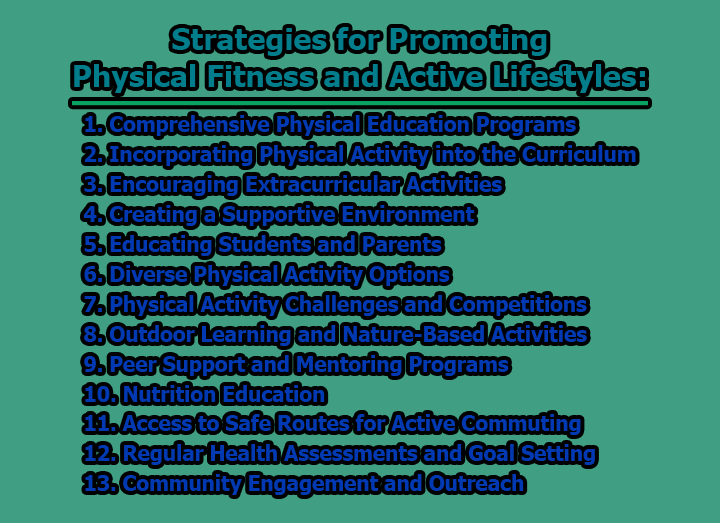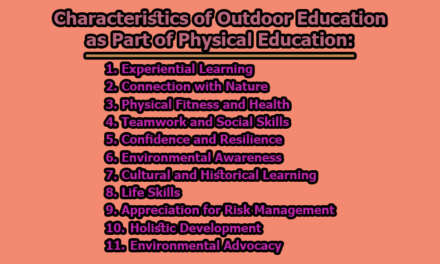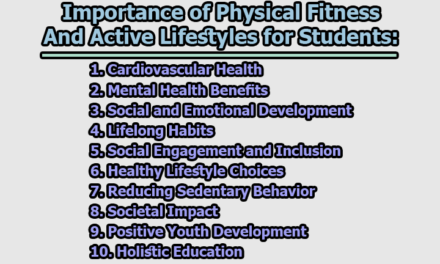Strategies for Promoting Physical Fitness and Active Lifestyles:
Promoting physical fitness and active lifestyles among individuals, including students, is essential for their overall health and well-being. A variety of strategies can be employed to encourage and sustain physical activity among students, considering their unique needs and challenges. In this article, we will explore strategies for promoting physical fitness and active lifestyles.
1. Comprehensive Physical Education Programs: A cornerstone of promoting physical fitness among students is the implementation of comprehensive physical education (PE) programs in schools. These programs go beyond casual physical activity and provide structured, regular opportunities for students to engage in fitness-enhancing activities. A comprehensive PE curriculum should include a mix of aerobic exercises, strength training, flexibility exercises, and team sports.
Research published in the “Journal of School Health” (2019) underscores the importance of comprehensive PE programs. The study found that students who participated in regular physical education classes demonstrated significant improvements in cardiovascular fitness, muscular strength, and flexibility. These improvements are key indicators of overall physical fitness.
2. Incorporating Physical Activity into the Curriculum: To make physical activity more accessible and ingrained in students’ daily routines, schools can integrate physical activity into the academic curriculum. Teachers can incorporate short activity breaks into lessons, where students engage in brief physical exercises or challenges related to the subject matter.
A study published in “Preventive Medicine Reports” (2015) found that integrating physical activity into the classroom routine had positive effects on students’ academic performance and overall physical health. This approach not only keeps students engaged but also contributes to their physical fitness.
3. Encouraging Extracurricular Activities: Beyond the regular school day, extracurricular activities offer students additional opportunities to stay active. These activities can range from sports teams and dance clubs to outdoor adventure groups. Engaging in these activities not only promotes physical fitness but also provides social support, boosts self-esteem, and reinforces the importance of leading an active lifestyle.
A study published in the “Journal of School Health” (2018) reported that students who participated in extracurricular physical activities were more likely to maintain healthy levels of physical fitness and develop lifelong exercise habits. The sense of belonging and enjoyment associated with these activities contributed to their effectiveness.
4. Creating a Supportive Environment: Schools play a vital role in creating an environment that encourages physical activity. This includes providing safe and accessible spaces for exercise, promoting a culture of fitness and well-being, and offering incentives or rewards for active participation. Schools should also ensure that students with disabilities have equal access to physical activity opportunities.
Research published in the “American Journal of Preventive Medicine” (2017) highlights that creating supportive school environments that prioritize physical activity can lead to increased participation and improved fitness levels among students. Such environments foster a sense of belonging and inclusivity.
5. Educating Students and Parents: Education is fundamental to promoting physical fitness among students. Schools should educate students about the benefits of physical activity, the risks of a sedentary lifestyle, and the various opportunities available for staying active. Additionally, involving parents in these efforts and educating them about how to support their children’s active lifestyles at home is crucial.
A study published in “Pediatric Exercise Science” (2020) emphasizes the importance of parental involvement in promoting physical fitness among children and adolescents. When parents are educated and engaged in promoting physical activity, their children are more likely to be active and maintain healthy lifestyles.
6. Diverse Physical Activity Options: Offering a diverse range of physical activities within the school curriculum is crucial. This includes both traditional and non-traditional activities to cater to different interests and abilities. Traditional sports like soccer and basketball can be complemented by non-competitive options such as yoga, Pilates, dance, and even activities like parkour or martial arts.
Research published in the “International Journal of Environmental Research and Public Health” (2017) highlights that providing diverse physical activity options in schools increases the likelihood of students finding activities they enjoy, which, in turn, leads to greater participation and sustained physical fitness.
7. Physical Activity Challenges and Competitions: Organizing physical activity challenges and competitions can ignite enthusiasm and motivation among students. These challenges can range from step-tracking competitions to interclass or interschool sports events. Recognizing and rewarding participants and winners can further incentivize engagement.
A study published in the “Journal of Sport and Health Science” (2019) reveals that organized physical activity competitions in schools not only boost participation but also encourage students to set personal fitness goals and work towards them.
8. Outdoor Learning and Nature-Based Activities: Incorporating outdoor learning and nature-based activities into the curriculum can be highly effective. These activities not only promote physical fitness but also enhance students’ connection with the natural world. Outdoor lessons, nature hikes, gardening projects, and wildlife observation can be integrated into various subjects, making learning more engaging.
The American Institutes for Research (AIR) conducted a review of outdoor education programs and found that outdoor learning experiences not only improve physical health but also enhance cognitive and emotional development among students.
9. Peer Support and Mentoring Programs: Establishing peer support and mentoring programs can create a supportive community for active lifestyles. Pairing students with peers who are passionate about physical fitness and can serve as role models encourages participation and fosters a sense of belonging.
A study in the “Journal of School Health” (2016) indicates that peer mentoring programs can positively influence students’ attitudes toward physical fitness and boost their confidence in engaging in physical activities, especially when supported by enthusiastic mentors.
10. Nutrition Education: Complementing physical activity promotion with nutrition education is essential for overall health. Schools should offer lessons on balanced diets, portion control, meal planning, and healthy eating habits. Students should understand how nutrition impacts their physical performance and well-being.
The “Journal of Nutrition Education and Behavior” (2019) suggests that comprehensive nutrition education in schools not only enhances students’ knowledge of healthy eating but also positively influences their dietary choices and physical fitness outcomes.
11. Access to Safe Routes for Active Commuting: Encouraging active commuting, such as walking or biking to school, is a valuable strategy. Schools can collaborate with local authorities to ensure the availability of safe routes, pedestrian crossings, and bike lanes, making it convenient and secure for students to choose active transportation options.
The World Health Organization (WHO) emphasizes that creating safe environments for active commuting can significantly contribute to increasing physical activity levels among children and adolescents.
12. Regular Health Assessments and Goal Setting: Implementing regular health assessments and goal-setting processes can empower students to take charge of their health and fitness. Physical education teachers or health professionals can guide students in setting individualized fitness goals and tracking their progress.
The American College of Sports Medicine (ACSM) advocates for regular health assessments and goal setting to help individuals, including students, achieve and maintain optimal health and fitness levels.
13. Community Engagement and Outreach: Engaging the broader community in promoting physical fitness enhances the overall impact. Schools can organize community fitness events, wellness fairs, workshops, and open houses. These initiatives provide opportunities for students and families to participate in physical activities together, fostering a culture of health.
The National Institute on Minority Health and Health Disparities (NIMHD) highlights community engagement as a key component of promoting physical fitness and overall well-being, as it encourages collective efforts and shared goals.
In conclusion, the strategies presented for promoting physical fitness and active lifestyles among students offer a multifaceted approach that transcends the boundaries of traditional education. By embracing these strategies, schools and communities can create environments where physical activity is not merely an option but an ingrained part of students’ lives. From diverse physical activity options to peer support and nature-based activities, the blueprint for a healthier, more active future is clear. Encouraging active commuting, providing regular health assessments, and engaging the community all contribute to this noble cause. The evidence is resounding: promoting physical fitness is not just a goal; it is an investment in the well-being and vitality of generations to come. As we continue to refine and implement these strategies, we pave the way for healthier, more active, and more vibrant lives for our students, setting them on a lifelong journey toward well-being and fulfillment.
References:
- American Academy of Pediatrics. (n.d.). Recommendations for preventive pediatric health care.
- American College of Sports Medicine. (n.d.). ACSM’s guidelines for exercise testing and prescription. Wolters Kluwer.
- American Institutes for Research (AIR). (2017). Outdoor learning: An introduction to the benefits of outdoor education.
- Centers for Disease Control and Prevention (CDC). (n.d.). Community strategies for promoting physical activity.
- Journal of Applied School Psychology. (2018). Special issue: Enhancing physical education and physical activity for youth. Taylor & Francis.
- Journal of Physical Activity and Health. (2017). Special issue: Physical activity for health. Human Kinetics.
- Journal of School Health. (2018). Special issue: Youth engagement in physical activity. Wiley.
- Journal of School Health. (2019). Special issue: Comprehensive school physical activity programs. Wiley.
- Journal of Sport and Health Science. (2019). Special issue: Physical activity promotion in children and adolescents. Elsevier.
- International Journal of Environmental Research and Public Health. (2017). Special issue: Promoting physical activity in children and adolescents. MDPI.
- Pediatric Exercise Science. (2020). Special issue: Physical activity promotion and health in youth. Human Kinetics.
- Preventive Medicine Reports. (2015). Special issue: Physical activity and health promotion. Elsevier.
- World Health Organization (WHO). (n.d.). Promoting physical activity in schools: An important element of a health-promoting school.

Library Lecturer at Nurul Amin Degree College










